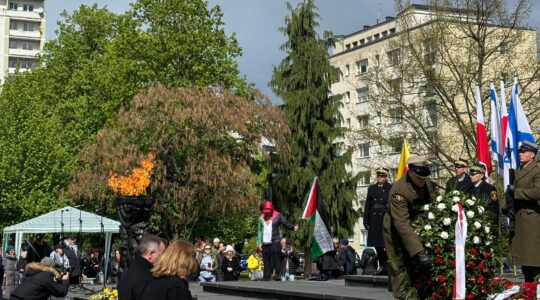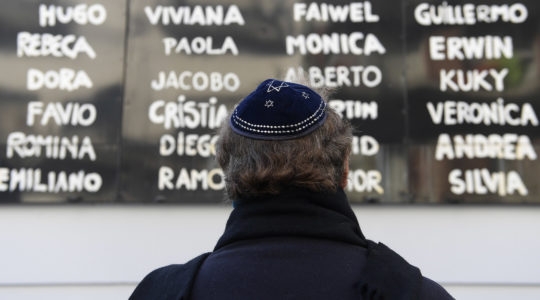LVOV, Ukraine, Dec. 27 (JTA) — Testifying to a rich Jewish past, museums in the western Ukrainian city of Lvov hold hundreds of Jewish artifacts that once belonged to local synagogues and Jewish institutions.
Now the few practicing Jews here say they need the artifacts back to reinvigorate their community.
“Our congregation is trying to bring Jewish tradition back, and we need these Torah scrolls and religious objects,” said Valentina Zamichkovskaya, 67, a member of the Lvov Reform Jewish congregation.
Ukrainian authorities seem open to the possibility.
“We are ready to transfer some items to the Jewish communities upon their request,” Roman Kurash, a representative of the Lvov Regional Administration in charge of religious affairs, told JTA.
“Ukrainian authorities are ready to resolve the issue on the condition that these objects are used for religious community purposes,” said Alexander Sagan, a senior adviser to President Viktor Yuschenko.
Lvov at one time was part of the Austro-Hungarian Empire and, between the world wars, was part of Poland. The city was incorporated into the Soviet Union in 1939.
When World War II began there were 1.5 million Jews in what is today Ukraine, or about 3 percent of the population. Lvov itself had more than 200,000 Jews, nearly half of them refugees from German-occupied Poland.
The Germans subsequently occupied Lvov after the invasion of the Soviet Union in June 1941. More than 6,000 Jews died in pogroms carried out by local residents in the summer of 1941— even before the Nazis set up a Jewish ghetto in Lvov in November 1941.
In March 1942, the Germans began deporting Jews from the ghetto to the Belzec extermination camp. By August 1942, more than 65,000 Jews had been deported and murdered. Thousands more were sent for forced labor to the nearby Janowska camp.
In early June 1943 the Germans destroyed the ghetto, killing thousands of Jews in the process. Remaining ghetto residents were sent to Janowska or deported to Belzec. Only a few hundred Jews survived the Holocaust in Lvov.
Artifacts such as Torah scrolls and ritual objects were confiscated from the Jewish community during the communist era. Lvov’s Museum of the History of Religion and the Museum of Ethnography and Crafts each contain about 1,000 Jewish artifacts.
“We have a good collection of Jewish manuscripts and over 420 Torah scrolls and fragments,” said Maxim Martyn, curator of the Museum of History of Religion’s Judaica collection.
Its holdings date from as far back as the 15th century; more recent objects are from the prewar Jewish community.
Lyudmila Bulgakova, chief curator at the Museum of Ethnography and Crafts, said her institution has an extensive collection of valuable ancient Judaica items, from Torah scrolls and velvet scroll covers to silver pointers and antique Jewish headwear.
Some of the artifacts are included in the museums’ permanent exhibitions, while some were shown at exhibitions in Israel and Poland. But many more remain unseen by the public.
Martyn said most of the Torah scrolls were transferred to the religion museum in the 1970s from a Lvov academic library after Soviet authorities shut down one of the city’s major synagogues in 1962.
Not all of the museum’s Judaica objects arrived there after being confiscated, he said: Some were donated by individuals who could not or were afraid to keep them.
For years the objects were used mainly in exhibitions, but with state-sponsored atheism and religious persecution mostly in the past, the revived Jewish community in Lvov wants the religious objects.
Lvov now is home to some 2,000 Jews. Aside from the Reform congregation, there’s a large Orthodox shul run by Rabbi Mordechai Shloime Bold, a Karlin-Stonliner Chasid. The synagogue was confiscated by the Bolsheviks but was returned to the community in 1989, shortly before the fall of communism.
Another Orthodox minyan, or prayer group, is run by a longtime Jewish community and human-rights activist, Meilach Sheichet.
Members of these groups acknowledge that many of the scrolls and Judaica objects may never be returned to proper religious use, given the small size of the community. But they insist the city should help the community transfer Judaica from municipal museums to a new Jewish museum that Jewish organizations want to open.
One of Ukraine’s chief rabbis was more categorical.
“Museums must return all Torah scrolls to the communities,” Rabbi Azriel Chaikin, a chief rabbi of Ukraine and the main Chabad-Lubavitch authority in the country, told JTA. “Religious silver and some other objects we can discuss separately, but Torahs must be returned.”
Even before any real negotiations have begun, at least one religious group in Lvov is using a scroll that belongs to a local museum. Sheichet said his Orthodox minyan borrowed a scroll from the Museum of History of Religion on a long-term loan.
Sheichet said many of the objects in the museum’s Judaica collection should be moved to a future Lvov Jewish museum, but another Ukrainian chief rabbi disagreed.
“Jewish religious objects were taken from synagogues during Soviet times,” Rabbi Yakov Dov Bleich, chief rabbi of Kiev and Ukraine, told JTA. “In independent Ukraine they should be returned to community property.”
Some of the Judaica artifacts were damaged or desecrated. Others are so ancient and valuable that synagogues and communal institutions may not want to keep them because of poor security.
One activist in Lvov said it would be wiser to split the Judaica holdings in local museums.
“Some of the objects can help the revival of Jewish communities,” journalist Boris Dorfman said, “while others will be better preserved in a future Jewish museum where they can tell incredible stories about the great Jewish past in our region.”
Lvov Jews: Give back our Judaica
Advertisement





